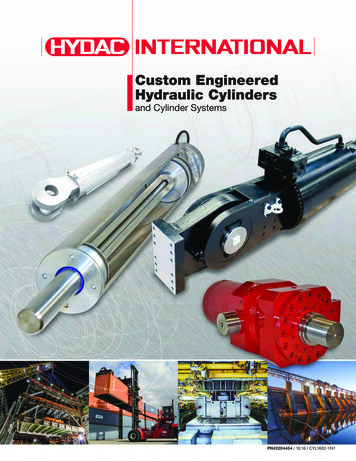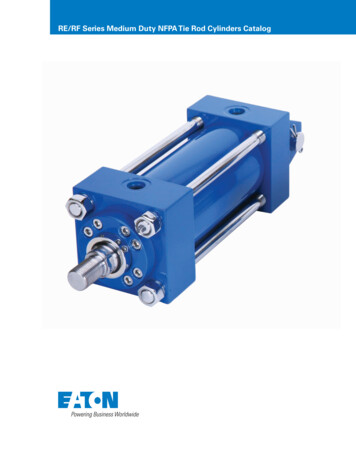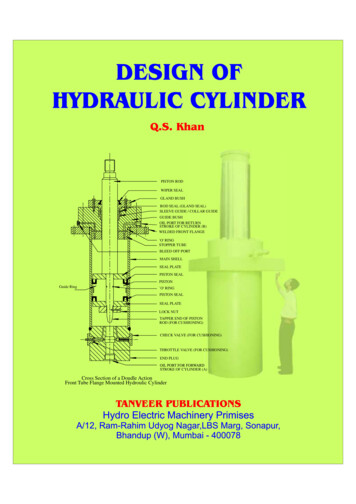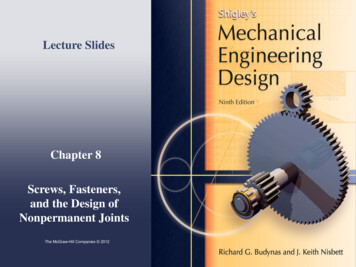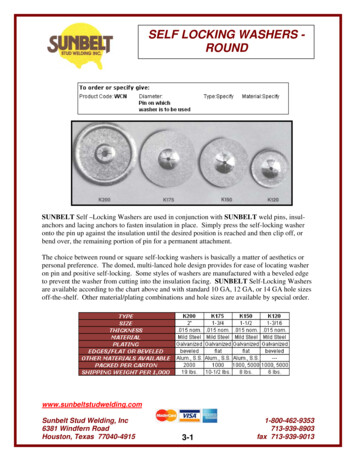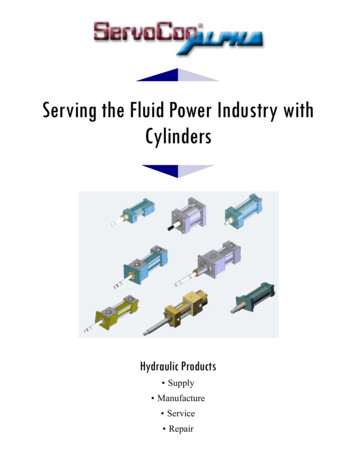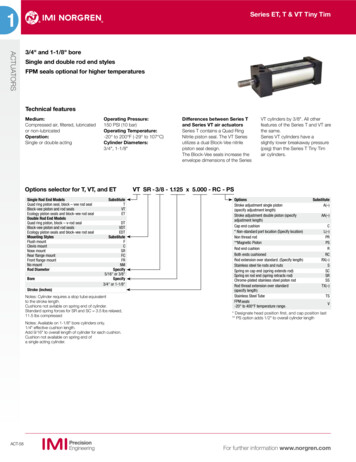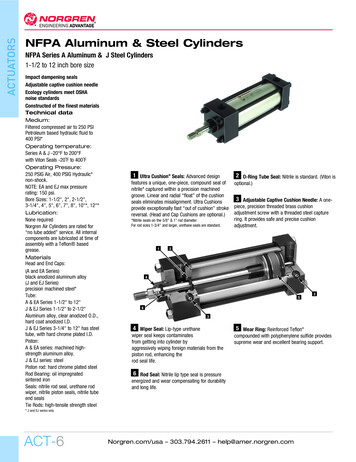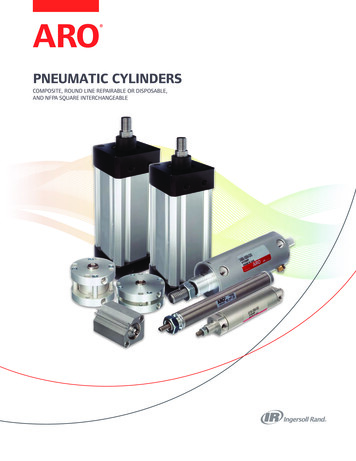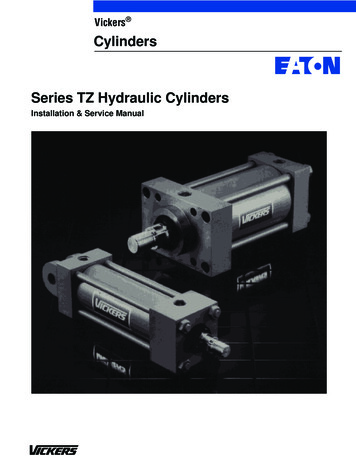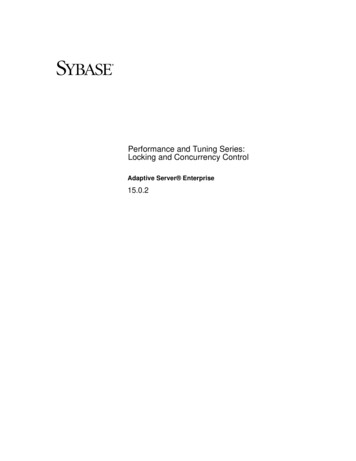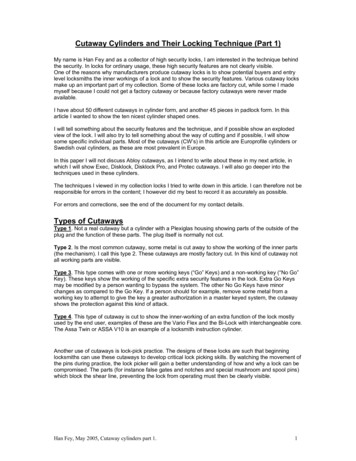
Transcription
Cutaway Cylinders and Their Locking Technique (Part 1)My name is Han Fey and as a collector of high security locks, I am interested in the technique behindthe security. In locks for ordinary usage, these high security features are not clearly visible.One of the reasons why manufacturers produce cutaway locks is to show potential buyers and entrylevel locksmiths the inner workings of a lock and to show the security features. Various cutaway locksmake up an important part of my collection. Some of these locks are factory cut, while some I mademyself because I could not get a factory cutaway or because factory cutaways were never madeavailable.I have about 50 different cutaways in cylinder form, and another 45 pieces in padlock form. In thisarticle I wanted to show the ten nicest cylinder shaped ones.I will tell something about the security features and the technique, and if possible show an explodedview of the lock. I will also try to tell something about the way of cutting and if possible, I will showsome specific individual parts. Most of the cutaways (CW’s) in this article are Europrofile cylinders orSwedish oval cylinders, as these are most prevalent in Europe.In this paper I will not discuss Abloy cutaways, as I intend to write about these in my next article, inwhich I will show Exec, Disklock, Disklock Pro, and Protec cutaways. I will also go deeper into thetechniques used in these cylinders.The techniques I viewed in my collection locks I tried to write down in this article. I can therefore not beresponsible for errors in the content; I however did my best to record it as accurately as possible.For errors and corrections, see the end of the document for my contact details.Types of CutawaysType 1. Not a real cutaway but a cylinder with a Plexiglas housing showing parts of the outside of theplug and the function of these parts. The plug itself is normally not cut.Type 2. Is the most common cutaway, some metal is cut away to show the working of the inner parts(the mechanism). I call this type 2. These cutaways are mostly factory cut. In this kind of cutaway notall working parts are visible.Type 3. This type comes with one or more working keys (“Go” Keys) and a non-working key (“No Go”Key). These keys show the working of the specific extra security features in the lock. Extra Go Keysmay be modified by a person wanting to bypass the system. The other No Go Keys have minorchanges as compared to the Go Key. If a person should for example, remove some metal from aworking key to attempt to give the key a greater authorization in a master keyed system, the cutawayshows the protection against this kind of attack.Type 4. This type of cutaway is cut to show the inner-working of an extra function of the lock mostlyused by the end user, examples of these are the Vario Flex and the Bi-Lock with interchangeable core.The Assa Twin or ASSA V10 is an example of a locksmith instruction cylinder.Another use of cutaways is lock-pick practice. The designs of these locks are such that beginninglocksmiths can use these cutaways to develop critical lock picking skills. By watching the movement ofthe pins during practice, the lock picker will gain a better understanding of how and why a lock can becompromised. The parts (for instance false gates and notches and special mushroom and spool pins)which block the shear line, preventing the lock from operating must then be clearly visible.Han Fey, May 2005, Cutaway cylinders part 1.1
The selection of 10 locks I will discuss are:-1 Zeiss-Ikon Sperwellen, Europrofile (Type 1)-2 Abus EC 850, Europrofile (Type 2)3 EVVA 3KS, Europrofile (Type 2)4 Winkhaus Titan, Europrofile (Type 2)5 ASSA 7-pin, Swedish Oval (Type 2)-6 EVVA DPI, Europrofile (Type 3)7 Ikon ZSE, ZSV, 0-level. Europrofile (Type 3)8 Alfa Vario Flex, Swedish Oval (Type 4)9 Bi-Lock, Swedish Oval (Type 4)10. Assa V10 / Assa Twin, Mortise Cylinder (Type 4)1. Ikon Sperwellen (Type 1)This cylinder contains 5 pairs of spring-loaded, active pins, including spool and inverse-spool pins toincrease pick resistance, and 4 additional finger pins controlling a sidebar. The wave-type lockingdevice is an additional code cut into the sides of the key. This code is sensed in the lock cylinder byspring loaded finger pins that govern the operation of the sidebar. If any of the codes at the key aremissing or incorrect, the lock cannot be operated. The finger pins must be lifted and rotated in thecorrect position before the sidebar (Gib) releases. With this system there are a few 1000 sidebarcodings.Exploded View—Ikon SK6 Wave Type Locking ProfileHan Fey, May 2005, Cutaway cylinders part 1.2
Cutaway—Ikon SK6 Wave-Type Locking ProfileThis cylinder works on the same principle similar to the Schlage Primus. The only differences I noticedin comparison with the Primus system is that Ikon system improves on the design by making thekeyway paracentric (which make it hard to use picktools), using spool pins and incorporating falsegrooves on the finger pins. In my opinion this lock is unpick-able.2. ABUS EC 850 (Type 2)ABUS is famous name throughout the world. The name ABUS is actually an abbreviation from AugustBremicker Und Sohne. The security from ABUS is based on more than 75 years of experience in thedevelopment and production of security products. Therefore, they have a quite an extended range ofsecurity products. One of these products is the EC 850 profile cylinder. EC stands for Extra Classe.This cylinder has 6 active pins in the top of the plug and 4 passive pins on the bottom of the plug. Thepins are placed in two independent and opposing rows. The dimple key has a symmetrical design.Exploded View—ABUS EC 750 / 850Han Fey, May 2005, Cutaway cylinders part 1.3
This cutaway is special in that it is cut on both sides of the cylinder and all working parts are visible.One side of the cylinder cannot rotate as it is blocked by a pin—otherwise the pins and springs wouldfall out.The lock has a patented anti-pick system. The high picking resistance is achieved with well-balancedmeasurements between top and bottom pins.Cutaway—ABUS EC8503. EVVA 3KS (Type 2)EVVA is well-known European manufacturer of cylinders that started business in 1919. EVVA standsfor Erfindungs-Versuchs-Verwertungs-Anstalt. From the very beginning EVVA made constantimprovements to its products, implanting them with technological innovations. Since the 1960s, EVVAhas been one of the most technologically advanced manufacturers of cylinders.This EVVA 3KS developed in 1993 is probably one of the most advanced mechanical locks and thecutaway one of the nicest that I have in my collection, because there is a lot to see.3KS stands for 3 Kurven System in German (in English, 3 Curve System) as it has 3 curves in the key.Exploded View—EVVA 3KSIn the exploded view, you can see the locking bars and the different locking pins also called sliders.There are 12 springless sliders, which contain together 18 control pins. These sliders have to bebrought in the right position to release the two locking sidebars. On each side in the plug (right andleft) there is one locking bar that prevents the plug from rotating. If the sliders and locking pins arepositioned correctly, the locking bar drops into slots on the sliders and the plug can rotate. When thelocking bar drops in the plug, the roller in the front of the cylinder drops in the stretched dimple in thefront of the key. The key is now caught in the plug and the roller prevents the key from being removedafter an incomplete rotation.Han Fey, May 2005, Cutaway cylinders part 1.4
In the cutaway you can also see the additional bottom bar. This bottom bar checks the edge profileson the bottom (or top) of the key. A correct key will match the bottom bar with the correct cut angles sothat the bottom bar can drop into the plug. If the cuts in the key do not have the matching profile cuts,this bottom bar will not drop into the plug, and the cylinder is prevented from rotating. This securityfeature can be easily bypassed by milling down the top (and/or bottom) of the key, as there would benothing to prevent the bottom bar from dropping into the plug.In the picture below you can see two different sidebars and some sliders. The sliders on the left haveone control pin. The sliders 2,3,4,5,6 and 8 are Masterkey sliders, because they have more gates. Thetwo sliders on the right (7 and 8) have double pins. On the bottom of the picture you can see thelocking sidebar.EVVA 3KS PartsOn the top of the key there is also a non-angled groove, where a kind of slider drops in. This sliderinsures that the key is fully inserted, before it can be rotated.Cutaway—EVVA 3KS Profile CylinderAs you look at the key you can see that the three waves have two different depths. Two waves areshallow and one is deep. This is because there are two kinds of sliders in the lock. The slider with thedouble pins traces the outside waves, and the slider with the single pin traces the deepest cut in themiddle of the key. Within the lock, the sliders alternate from single pin to double pin slider and back tosingle pin again. The pins in this lock are covered by Teflon to resist wear and tear.Han Fey, May 2005, Cutaway cylinders part 1.5
The double pin sliders can have 7 different positions and the 1 pin slider can have 9 differentpositions. This gives the tremendous number of keys of 30.000.000.000.000 because of the9*7*9*7*9*7*9*7*9*7*9*7 combinations in sliders. This means if we should put all the different keysend-to-end they would have a length of 64.000.000 kilometers that’s equal to 1650 around the earth,or equal to 10 times the number of humans on earth today. EVVA claims that the lock is unique as afingerprint with some imagination you might say that the waves in the key look like the waves from afingerprint.These locks can be serviced by a locksmith who can make simple masterkey systems; therefore thelock shop has blanks which a certified locksmith gets from the factory. These blanks come with the twowaves pre-milled on the outside of the key. The only thing the locksmith does is to mill the third waveinto the key.Note that this reduces the number of possible combinations within any one “blank” to roughly one-halfmillion.An EVVA 3 KS Blank (top) and Cut key (bottom)These locks normally come with a security card. This card is necessary to obtain extra keys. Showingthe card is insufficient to get new keys. As an extra security feature, the special number on thekeycard must be typed into the key duplicating machine in order to instruct the machine to make thatspecific profile. Without the correct number, it is normally not possible to make duplicate keys.4. Winkhaus Titan (Type 2)The Winkhaus Titan is a high security cylinder from the 1980’s. With 4 security features containedwithin it, it is in my opinion, the most sophisticated mechanical cylinder that Winkhaus has everproduced.The first security feature has six pin tumblers, drill protection, and specially shaped pins to frustratelock picking.The second line of defense is that it uses a restricted key profile. The profile variations are over theentire keyway height. Each profile rib overlaps the centreline to frustrate the use of picktools.It’s third security feature is the use of the Kalotten. Up to 10 passive pins control the side of the key.On each side of the key there are 5 Kalotten possible. It is a passive system. If the matching dimplehole in the key is missing, the Kalotte is pushed out, and blocks the cylinder. By drilling 5 extra dimpleholes per side into the key, you can bypass this system.The fourth security feature are the “actively passive” Kiphebel Stifte. Up to 10 (5 per side) KiphebelStifte block the plug when either a key is missing, or a key is inserted which can pass the physicalbarriers of the plug but still is not the “correct” profile.Han Fey, May 2005, Cutaway cylinders part 1.6
The third and fourth security features make the lock more difficult to pick. If you touch these parts witha picktool while there is tension on the plug, they automatically block the rotation of the plug andbecome stuck. They make the function of the lock sensitive to the exact profile of the key as well as tothe tumbler cuts.Winkhaus claims 27.000.000.000 different keys with 100 different profiles.The Four Security Features in a Winkhaus TitanIn this exploded view, you can see all the working parts in this cylinder.Exploded View—Winkhaus TitanAs there are a least 25 extra holes necessary for security features 3 and 4 on the inside of thecylinder. Winkhaus made a second housing around the plug where the holes are which block thecylinder. I believe this makes the lock easier (cheaper) to produce.In the cut-away, you can see the 15 possible holes on one side of the plug. This is my only cylinderwere there are two housings around the plug.Everything assembled in one cylinder results in the picture below. If you have a close look at the frontof the cylinder you can see the two metal pins which function as drill protection.Han Fey, May 2005, Cutaway cylinders part 1.7
Cutaway—Winkhaus Titan Profile CylinderWinkhaus also produces these cylinder for the French company Fichet. The only difference betweenthe two is the keyway and the brand name on the bow.In the picture below, you can see the specific bow shape of this system and you can also see thedimple holes on the different sides of the key.Winkhaus Titan Keys5 ASSA 7-Pin (Type 2)The ASSA 7-Pin is the standard high security lock in Sweden. This cylinder also contains thesneakiest pins I have ever seen. I have made this cut-away myself, as I don’t know of a factorycutaway that has ever been distributed.The first, second, fourth, and sixth pins have standard special lower pins and special spool driver pins.The bottom ends of these spooled pins are turned down to a smaller diameter then the pin barrel, andare then rounded at the ends, enhancing their pick resistance effectiveness. The pin chamber countermilling on pins 1, 2, 4, & 6 causes the spools to latch-up tight if the bottom pins are not raised to thecorrect height. In the picture below, you can see the plug with the specific extra counter-milling in thebefore-mentioned chambers. In an ASSA Twin and V10 these counter millings are in all six chambers.The third and fifth pins are standard anti-drill pins.Han Fey, May 2005, Cutaway cylinders part 1.8
Assa 7-Pin PlugChambers 1, 2, 4, & 6 contain the sneaky pins.Sneaky PinsThe next picture shows the placement of all the pins within the cylinder.Parts in an ASSA 7-Pin CylinderASSA has produced these 7-pin cylinders for a very long time. You can recognize the newest versionof these cylinders by the characters “SDC” on the front of the cylinder. This means drill protection hasbeen added to the aforementioned features, adding two extra drill protection pins in the plug betweenthe second and the fourth chambers.Han Fey, May 2005, Cutaway cylinders part 1.9
ASSA 7 pin cut-away Oval cylinder6. EVVA DPI (Type 3)This section, profiles another nice cylinder from EVVA, this time the DPI system. The characters DPIstand for Doppel Profil Integriert, In English, Double Profile Integrated. The term double, because inaddition to the keyway profile protection there is also an active side bar in the left side of the plugwhich is controlled by the side of the key. The millings in the key must match with the side bar. Thissystem has 3 security parameters within it: the shape of the keyway, the sidebar, and the 5 pintumblers.In the exploded view, you can see clearly the shape of the side bar and its millings.Exploded View—EVVA DPI Cylinder Showing the Side BarIn the picture below, you can see this side bar build in the cutaway and you can see the special clipdesigned by Zeiss-Ikon which provides pull-out protection from the cylinder.Han Fey, May 2005, Cutaway cylinders part 1.10
Cutaway—EVVA DPI Profile CylinderThis cutaway comes with three different keys. The normal cuts in these keys for the 5 pin tumblers arethe same—the only difference between these keys is the side bar milling.Key 1 (top) is the correct key. The side bar drops perfectly into the side bar milling in the key, allowingthe sidebar to drop into the plug, allowing the plug to rotate.Key 2 (middle) has an incorrect sidebar milling, thereby pushing the side bar out of the plug andinhibiting rotation. The side bar prevents the plug from rotating, despite the fact that the normal lockingpins have created a correct shear line.Key 3 (bottom) has the side bar millings totally milled flat. This can be done by persons who want tobypass the system. This prevents the sidebar from being pushed out of the plug due to the deepmilling on the side of the key. The system, however, is designed so that the sidebar now drops toodeep into the plug. Although the key can turned counterclockwise 90 , it will then be blocked, as pin 3is pushed into the plug.In normal locks this blocking is irreversible; in the cutaway this option can be reset.EVVA DPI System Keys with Different Side Bar MillingsHan Fey, May 2005, Cutaway cylinders part 1.11
EVVA also offers the DPX-system. This system is similar to the DPI system, but has 2 sidebars (oneon the left and one on the right) in the plug, therefore also different sidebar millings on each side of thekey.Note: The chambers in the housing of this cylinder are drilled in two different diameters. The spring isin a more narrow diameter. If you should succeed in removing the springs by drilling a small hole in thefront in order to let the pins fall down, they will stick in the chamber of the housing. The use of a combwith this cylinder is also not possible.7. Ikon SK6 ZSV (Level 2), ZSE (Level 1) and Level 0 (Type 3)This name of this German Ikon system is SK6 with diagonal profile. It is used in large grand masterkeyed (GMK) systems with differing security levels.The profile of the key is arranged at an angle in relation to the back of the key. In the cylinder core, theprofile of the keyhole runs diagonally in relation to the axis of the lock cylinder. This is one of thesecurity features of this locking system.Level 0 of this system only has the normal 6 pins and the diagonal key-profile. It’s the lowest securitylevel in this system. You can easily recognize the key in this system because it has no dimple holes onthe side of the key.Exploded View—Ikon System SK 6, Security Level 0The same cylinder can be easily lifted up to a higher security level called ZSE. An additional coding onthe key is sensed in the lock cylinder by additional blocking elements in the plug. If any of the codes inthe key are missing or incorrect, the lock cannot be operated. You can recognize this level by the twodrilled holes on the side of the key.Han Fey, May 2005, Cutaway cylinders part 1.12
Exploded view—Ikon System SK 6, Security Level 1 (ZSE)The ZSV level is the highest level in this system and the key has an extra additional coding which canvary. This system is used in large GMK systems in order to meet increased security requirements.You can recognize the key by the extra dimples on the side of the key.Exploded View—Ikon System SK 6, Security Level 2 (ZSV)The cutaway of this system comes with three keys, the only difference of which is the sidebar coding.The goal of this cut-away is not to show the normal pins, but to show the extra security levels. Thecylinder is cut only from the top to show these extra security features.Ikon SK6-diagonal profile ZSE / ZSV cut-away profile cylinderHan Fey, May 2005, Cutaway cylinders part 1.13
The key at the top is a level 0 key and does not operate both sides of the cylinder as the dimple holesare missing in the key.The middle key is a level 1 key and operates the ZSE side of the cylinder.The bottom key is a level 2 key in the system. This key has the highest authorization, and cantherefore operate the locks with the highest security level in the system. In addition to operating Level0 cylinders, it also operates both the ZSE and the ZSV sides of the cylinder. There are three dimpleholes on the side of the key.Ikon Level 0, 1, and 2 KeysWhat I find nice about this CW is that 3 levels of security are demonstrated in one cylinder.8. Alfa Vario Flex (Type 4)This Swedish oval cylinder has 7 pins. In the cutaway, you can see all 7 chambers and the specificmushroom-shaped top pins this brand uses. What I find special about his cutaway is the straight line ofcutting from the oval housing—they made two cuts with a milling machine and the cutaway was ready.The first 6 chambers are filled with normal upper pins (some mushroom shaped) and lower pins. Theseventh chamber is filled with pins for the special Flex function of this lock.The Flex function allows the lock to come with three different keys: keys V1, V2, and R3. After keyloss, the cylinder can be easily programmed to the next key. In normal use, the 6 pins should giveenough variety and protection to make this cylinder a high security cylinder. In the last chamber(number 7) are the change pins. This chamber is filled with 6 different pin parts. In the picture, you canonly see 5 pins because the lower pin is not visible. The diabolic-shaped pins make the difference (2pieces). These pins are pushed into the special holes in the plug. To make a smooth rotation possible,the diabolic shaped pins are captured between two flat pins. Beside these pins are also the normallower pin and top pin. This makes 6 pins in this chamber.This cylinder is made by GEGE, a member of the Kaba Bauer group.Cutaway—ALFA Flex Oval CylinderHan Fey, May 2005, Cutaway cylinders part 1.14
In the picture below, you can see the three keys that come with the lock. You can see that the last pinis lifted higher every key change.ALFA Flex Change Key Set9. Bi Lock (Type 4)The Bi Lock system comes from Australia. This Bi Lock cutaway consists of a plug with 2 sidebarscontrolled by two parallel rows of six pin tumblers, each row acting independently with its own side bar,and a cap that holds the pins and springs in the plug. The pins are just lifted, they are not controlled onan angle.Each side of the lock is operated separately by each half of the dual-bladed key.When the key is inserted into the lock, the pin tumblers are properly located to form a shear line oneach side of the lock. This allows the spring-loaded sidebars to locate the deep holes on the tumblersand to retract, allowing the lock to be opened. When the key is returned to the locked position andwithdrawn, the spring-loaded side bars are forced into the slots in the lock body. In the locked position,all tumblers are the same height and rest on the bottom of the keyway, making it impossible to readthe combination or impression the key.What I find special about this cutaway is that it comes with the QCC (Quick Change Core) function,which provides the unique ability to recombinate the lock within seconds. Therefore, this lock comeswith an operating key and a QCC key. With the QCC key you can remove the core and change it. Thiskey has a drilled hole to receive a ball bearing which normally locks the plug into the housing.Han Fey, May 2005, Cutaway cylinders part 1.15
Cutaway—Bi Lock Cylinder with Operating Key (top) and QCC Key (bottom)Cutaway—Bi Lock Cylinder with QCC FunctionEssential to the Bi Lock system is the unique dual-bladed, "U" shaped key. Each side of the key is cutdifferently and engages its own set of pin tumblers and side bars. The key blank is flat; the blank canonly be cut and formed with proprietary equipment at the factory, or at an authorized Bi Lock servicecentre. The blank is cut to code on both sides and then formed into the "U" shape, a patented process.The coloured key head (18 different colors) is then inserted and crimped securely into place.Production of Bi Lock cylinder keyHan Fey, May 2005, Cutaway cylinders part 1.16
10. Assa 6000 (Twin) & V10 (Type 4)In 1981, ASSA celebrated its 100th anniversary with the release of the ASSA Twin 6000, a newcylinder utilizing the dual locking mechanisms of today's ASSA cylinders. Two independent lockingmechanisms are simultaneously operated by a special shaped key. Both the key and sidebarincorporate precision coding.Exploded View—ASSA Twin 6000In 1996, ASSA introduced the improved version of the ASSA 6000 called the V10. The innovative V10key design and cylinder helped to eliminate unauthorized duplicate keys and to maintain a key controlsystem that is unmatched in the industry.The first locking system in the ASSA 6000 and V10 (also named the Twin 2) contain 6 pin tumblers.There are 9 different lengths of bottom pins. The number one cut is the shallowest cut in the key andhas therefore the longest pin in the plug. To enhance pick resistance, spool driver pins are caught bycounter milling in the cylinder plug when rotational force is applied.The second locking system is the sidebar. The side bar can be pushed into the plug if the 5 side pinsare lifted correctly. There are 5 different depths possible for each side pin. False grooves in the sidepins catch the sidebar when improperly positioned.The 5 side pins in the lock are all the same. The difference in the side bar system is created by theside bar itself. The side bar has a specific code number which identifies the notch pattern on it. Theside bar cuts in the key must match with this set of side bar notches. If the side bar cuts do not matchwith the side bar profile in the key, the lock cannot be operated as the side pins are lifted into thewrong positions.If you are an authorized ASSA Twin or V10 dealer it is possible to get your own sidebar code.This means that you can make GMK systems yourself by changing the pin tumblers in the first lockingsystem. The side bar code is for every key in the system the same. In very big GMK systemsproduced by the factory, even the sidebar profiles can vary.Han Fey, May 2005, Cutaway cylinders part 1.17
Cutaway—ASSA Twin 6000The Twin 6000 and the V10 are the nicest cutaways in my collection, as there is so much to see. Thecutaways that I have come in two different versions, the demo and the instruction version.The demo cylinder on the left is used to show people the working of the mechanism. You canrecognize this version by the top pin, in which both sides are mushroomed (right pin below).Spool driver pins used in a Twin/V10 Instruction and Demo cylinderThe lock on the right is used in locksmith classes. The potential locksmith has to disassemble thecylinder to rotate the sidebar in the lock, after doing this the old key will not fit any more, therefore twodifferent keys are provided with this lock. The only difference between the keys is the sidebar milling.The spool driver pins in this cutaway are only mushroomed on one side, as an extra to test of thequality of the locksmith.Han Fey, May 2005, Cutaway cylinders part 1.18
Cutaway—ASSA V10 Demo Cylinder (left) and Instruction Cylinder (right)A locksmith which services the Twin or V10 and is allowed to make a GMK system may have twodifferent sidebar profiles in his shop, which fit into each other (see picture below).Mirrored Side Bar cuts, (used with one side bar)ASSA uses 4 different lengths of top pins (spool driver pins). These lengths are combined with thelength of the bottom pin. This is done to reduce the stress in the springs. If you should use a longbottom pin in combination with a long spool driver pin, the stress could weaken the spring.The length of the bottom pin and top pin in combination with the chamber prevents the use of a combpick.A comb pick is a kind of rake which is inserted into the keyway. This comb lifts the top pin and bottompin both out of the plug and into the housing so that the plug is no longer blocked. This does not workin the Twin system because of the two independent locking mechanisms.The different length of top pins is also one of the tricky parts for the locksmith in training. The length ofthe spool driver pin must match with the length of the bottom pin.It’s a pity that the cutaway does not show the extra groove in the chamber where the mushroom iscaught. In the ASSA 7-pin you see a plug with the same principle.One of the things ASSA improved in the V10 as compared to the Twin 6000 is the sidebar pins Theymade them more streamlined and the pins may now be positioned in the front or the back of thegroove in the sidebar. This option is used in masterkey systems.Han Fey, May 2005, Cutaway cylinders part 1.19
V10 key with front and rear positioned sidebar pinsClosing commentsSo far my article has been about cylinder cutaways. There are a lot more locking systems in cutawayversions which I find personally worth writing about—for example, the Zeiss-Ikon Magnet system, theKaba Quattro, EVVA Dual, BKS Multipin, Zeiss-Ikon Sperrippen, Wilka ZL-pro with the magneticinserts in the plug, the DOM Diamant, Mottura with magnetic pins, etc. All of these locks have incommon special security features which make them hard to manipulate.You can download this file with the next link “www.toool.nl/cutaway1.pdf” where you can see thepictures in this article in more detail and in color.If you have seen some errors or things which need to be corrected, you can contact me at:han.fey@12move.nl.I hope you have enjoyed reading this article.Han FeyThe NetherlandsHan Fey, May 2005, Cutaway cylinders part 1.20
List of Factory Cut-way CylindersABUS C93ABUS EC 850ASSA DesmoASSA Twin 6000 demo cylinderASSA Twin 6000 instruction cylinderASSA V10 Demo cylinderASSA V10 Instruction cylinderBKS MultipinBKS SLDOM ix-5kgDOM ix-6kgDOM ix-0kgDOM CDDOM DEVVA DualEVVA DPIEVVA 3KSGTV SEMKaba Gemini SKaba Gemini TKaba QuattroKaba StarMedecoMedeco BiaxialMedeco M3Mul-T-lockMul-T-Lock InteractiefNemef KB6Pfaffenheim P25Pfaffenhaim D25 GMKSchlage EverestSchlage PrimusWinkhaus VS 5Winkhaus VS 6Winkhaus TitanZeiss-IkonHan Fey, May 2005, Cutaway cylinders part 1.21
positions. This gives the tremendous number of keys of 30.000.000.000.000 because of the 9*7*9*7*9*7*9*7*9*7*9*7 combinations in sliders. This means if we should put all the different keys end-to-end they would have a length of 64.000.000 kilometers that’s equal to 1650 around the earth,
